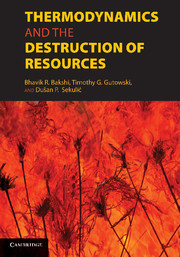Book contents
- Frontmatter
- Contents
- Contributor List
- Foreword by Herman E. Daly
- Foreword by Jan Szargut
- Preface
- Introduction
- PART I FOUNDATIONS
- PART II PRODUCTS AND PROCESSES
- PART III LIFE-CYCLE ASSESSMENTS AND METRICS
- PART IV ECONOMIC SYSTEMS, SOCIAL SYSTEMS, INDUSTRIAL SYSTEMS, AND ECOSYSTEMS
- 14 Early Development of Input–Output Analysis of Energy and Ecologic Systems
- 15 Exergoeconomics and Exergoenvironmental Analysis
- 16 Entropy, Economics, and Policy
- 17 Integration and Segregation in a Population – a Thermodynamicist's View
- 18 Exergy Use in Ecosystem Analysis: Background and Challenges
- 19 Thoughts on the Application of Thermodynamics to the Development of Sustainability Science
- Appendix: Standard Chemical Exergy
- Index
- References
16 - Entropy, Economics, and Policy
Published online by Cambridge University Press: 01 June 2011
- Frontmatter
- Contents
- Contributor List
- Foreword by Herman E. Daly
- Foreword by Jan Szargut
- Preface
- Introduction
- PART I FOUNDATIONS
- PART II PRODUCTS AND PROCESSES
- PART III LIFE-CYCLE ASSESSMENTS AND METRICS
- PART IV ECONOMIC SYSTEMS, SOCIAL SYSTEMS, INDUSTRIAL SYSTEMS, AND ECOSYSTEMS
- 14 Early Development of Input–Output Analysis of Energy and Ecologic Systems
- 15 Exergoeconomics and Exergoenvironmental Analysis
- 16 Entropy, Economics, and Policy
- 17 Integration and Segregation in a Population – a Thermodynamicist's View
- 18 Exergy Use in Ecosystem Analysis: Background and Challenges
- 19 Thoughts on the Application of Thermodynamics to the Development of Sustainability Science
- Appendix: Standard Chemical Exergy
- Index
- References
Summary
If Thought is capable of being classed with Electricity, or Will with chemical affinity, as a mode of motion, it seems necessary to fall at once under the second law of thermodynamics as one of the energies which most easily degrades itself, and, if not carefully guarded, returns bodily to the cheaper form called Heat. Of all possible theories, this is likely to prove the most fatal to Professors of History.
Henry Brooks Adams (1838–1918), U.S. historian. The Degradation of the Democratic Dogma, p. 195.Introduction
Modern, mainstream economics is as much a product of social and political history as it is of the scientific method. The decline of centralized power in the late middle ages, held previously by kings, feudal lords, bishops, or priests, increasingly provided opportunities for individuals and their communities to determine their own fate. As the roles and responsibilities of individuals were redefined and as decision making became decentralized, concerns were raised whether a society, driven by individuals and their self-interests, could and would be able to reach some stable outcome [1, 2]. As some of the societies in Western Europe experienced rapid change, new technologies broadened the resource base – domestic and foreign – with opportunities for seemingly unbounded expansion of the human enterprise. Most notably, the technological innovations of the agricultural and industrial revolutions fueled, and were driven by, economic growth and social change.
- Type
- Chapter
- Information
- Thermodynamics and the Destruction of Resources , pp. 402 - 428Publisher: Cambridge University PressPrint publication year: 2011

